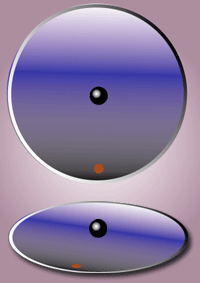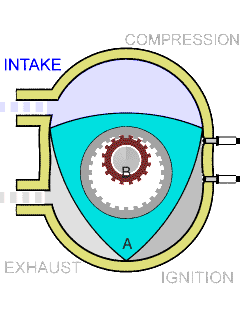
Tuesday, November 24, 2009
Coriolis effect

Sunday, November 1, 2009
Meta-Words
Here's a great list of more words about words, including "bibliobibuli" ("people who read too much and so are generally oblivious to the world around them -- coined by H.L. Mencken"), along with classics such as "palindrome" (which is not an Alaskan ant), and every possible "-nym" word (antonym, homonym, etc.).
Monday, October 19, 2009
Steampunk

Friday, October 9, 2009
Stroop Effect

Friday, September 25, 2009
Good, Fast, and Cheap

The Project Triangle is a concept in project management that saves teams from destruction by overly-demanding customers. "You are given the options of Fast, Good and Cheap, and told to pick any two. Here Fast refers to the time required to deliver the product, Good is the quality of the final product, and Cheap refers to the total cost of designing and building the product. This triangle reflects the fact that the three properties of a project are interrelated, and it is not possible to optimise all three – one will always suffer."
This idea spawned the title of the 1997 Erol Morris film, "Fast, Cheap and Out of Control".
Thursday, September 17, 2009
Exponential Information Video
Tuesday, September 15, 2009
Kübler-Ross model
It describes, in five discrete stages, a process by which people allegedly deal with grief and tragedy, especially when diagnosed with a terminal illness or catastrophic loss. In addition to this, her book brought mainstream awareness to the sensitivity required for better treatment of individuals who are dealing with a fatal disease."
Thursday, September 10, 2009
Maslow's hierarchy of needs

Friday, September 4, 2009
The Fat Man and the Trolley
"A trolley is running out of control down a track. In its path are 5 people who have been tied to the track. Fortunately, you can flip a switch, which will lead the trolley down a different track to safety. Unfortunately, there is a single person tied to that track. Should you flip the switch?"
Most people would answer 'yes', given that saving five people is "better" than saving one. An interesting tweak on this:
"As before, a trolley is hurtling down a track towards five people. You are on a bridge under which it will pass, and you can stop it by dropping a heavy weight in front of it. As it happens, there is a very fat man next to you - your only way to stop the trolley is to push him over the bridge and onto the track, killing him to save five. Should you proceed?"
Now the survey participant might get a little squirmish. Why is that? The moral calculas is the same (saving 5 versus saving one).
Monday, July 20, 2009
Wankel Engine

Monday, July 13, 2009
Laser Chess

Tuesday, July 7, 2009
Kunstformen der Natur
 |  |  |  |
Conway's Game of Life

Conway's Game of Life is an example of a simple cell automaton program. Imagine a piece of graph paper in which the squares are randomly either filled or empty. That graph paper represents the "organism" at zero generations. For each square (filled or empty), there are rules that govern whether it will be "alive" (filled), or "dead" (empty), in the next generation (represented by a second sheet of graph paper). Here are the rules:
"The universe of the Game of Life is an infinite two-dimensional orthogonal grid of square cells, each of which is in one of two possible states, live or dead. Every cell interacts with its eight neighbours, which are the cells that are directly horizontally, vertically, or diagonally adjacent. At each step in time, the following transitions occur:
- Any live cell with fewer than two live neighbours dies, as if caused by underpopulation.
- Any live cell with more than three live neighbours dies, as if by overcrowding.
- Any live cell with two or three live neighbours lives on to the next generation.
- Any dead cell with exactly three live neighbours becomes a live cell.
The initial pattern constitutes the 'seed' of the system. The first generation is created by applying the above rules simultaneously to every cell in the seed — births and deaths happen simultaneously, and the discrete moment at which this happens is sometimes called a tick. (In other words, each generation is a pure function of the one before.) The rules continue to be applied repeatedly to create further generations."